In June of 2023, I planted a GEM avocado tree. It was a good-looking tree, on top and bottom. The leaves showed healthy new growth and the roots were abundant and with new white tips. I planted in the best way I knew, a way in which I’d planted many trees before that grew into productive mature trees. Here it was on planting day:
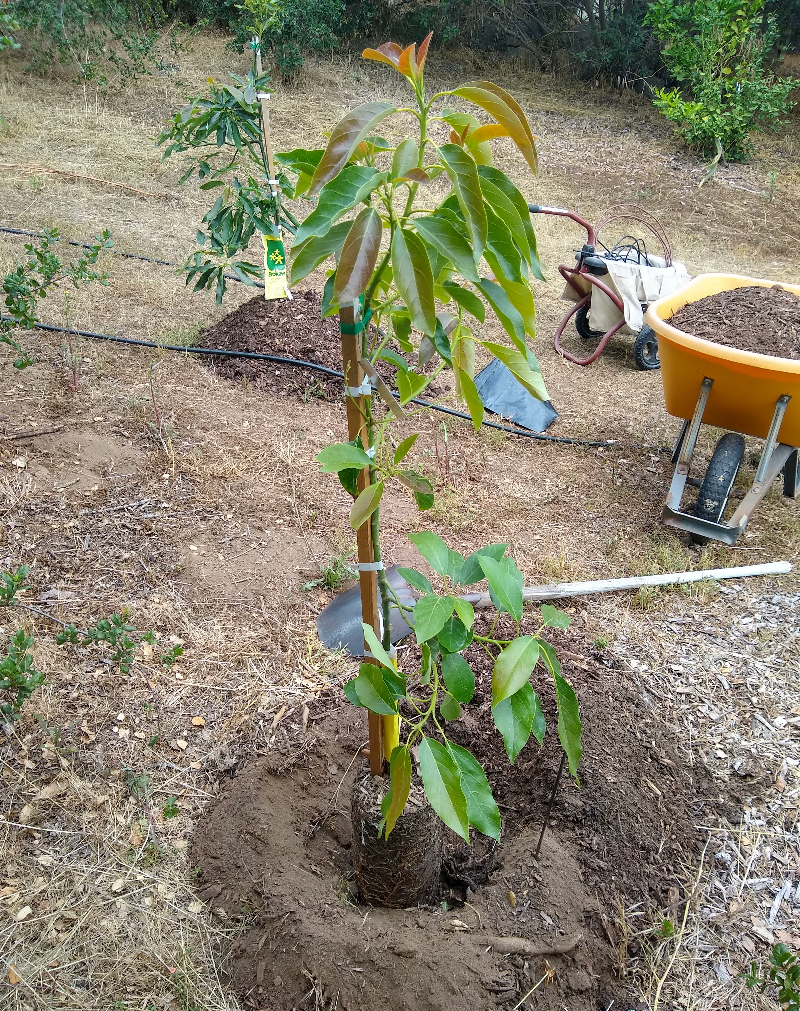
All looked perfect through that first summer. And at the end of the first year, 2023, the GEM was as big and healthy as I could hope. I patted myself on the back for having taken good care of it. Here it was at the beginning of its second year.
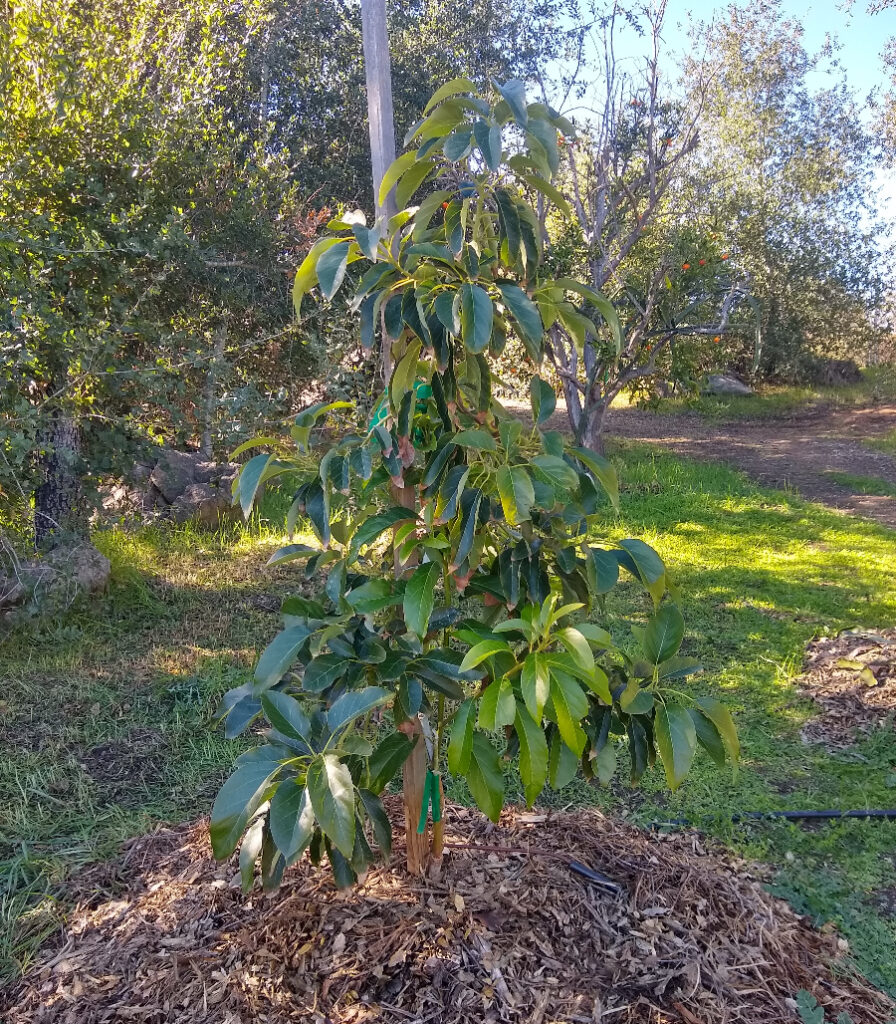
But when the GEM began to flower in spring, some leaves started to show brown edges.
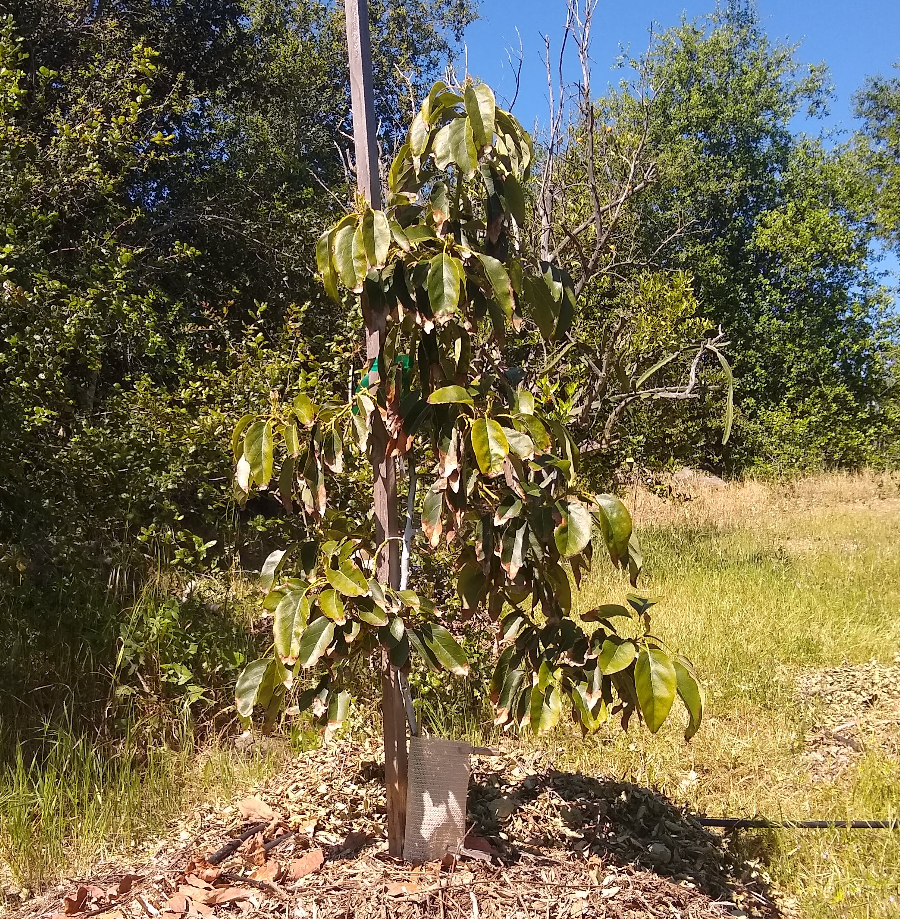
The tree continued to grow, however, and while its new leaves were a bit smaller than they should have been, they were fully green.
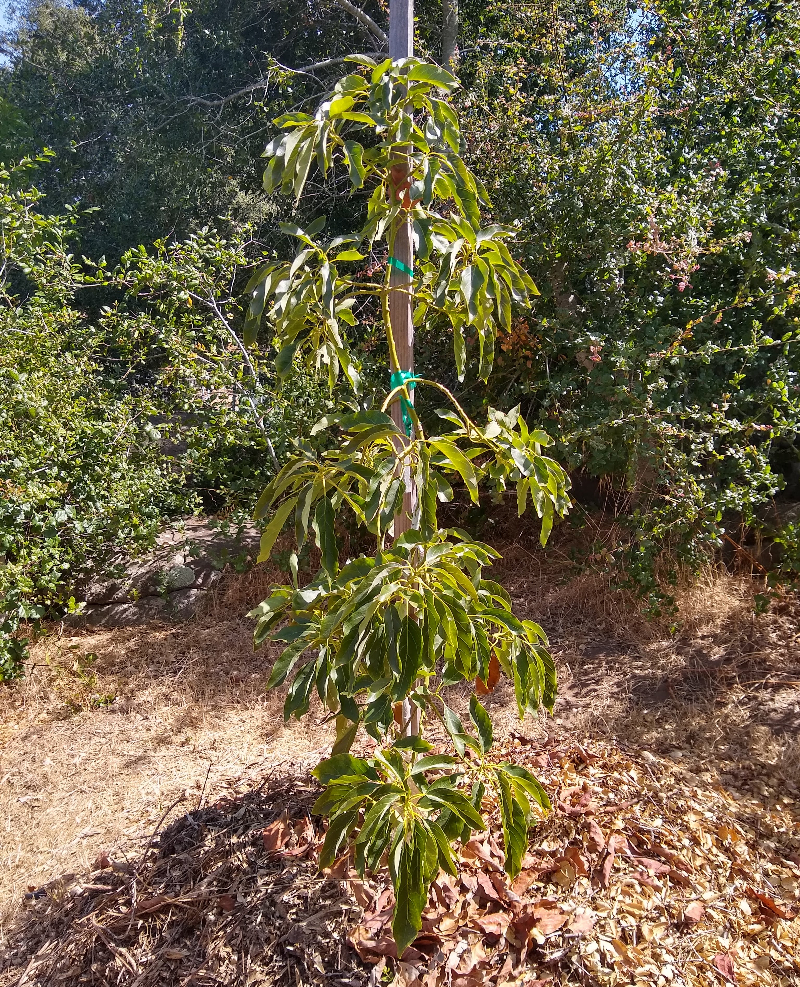
Until it really warmed up.
On June 22, the temperature reached 103. On July 5, the temperature reached 101. It was over 100 again the following week. The GEM avocado tree’s leaves began to brown.
I thought I had been watering enough. I added a cover of shade cloth to give the tree relief, and I watered even more. But the leaves did not stop drying up.
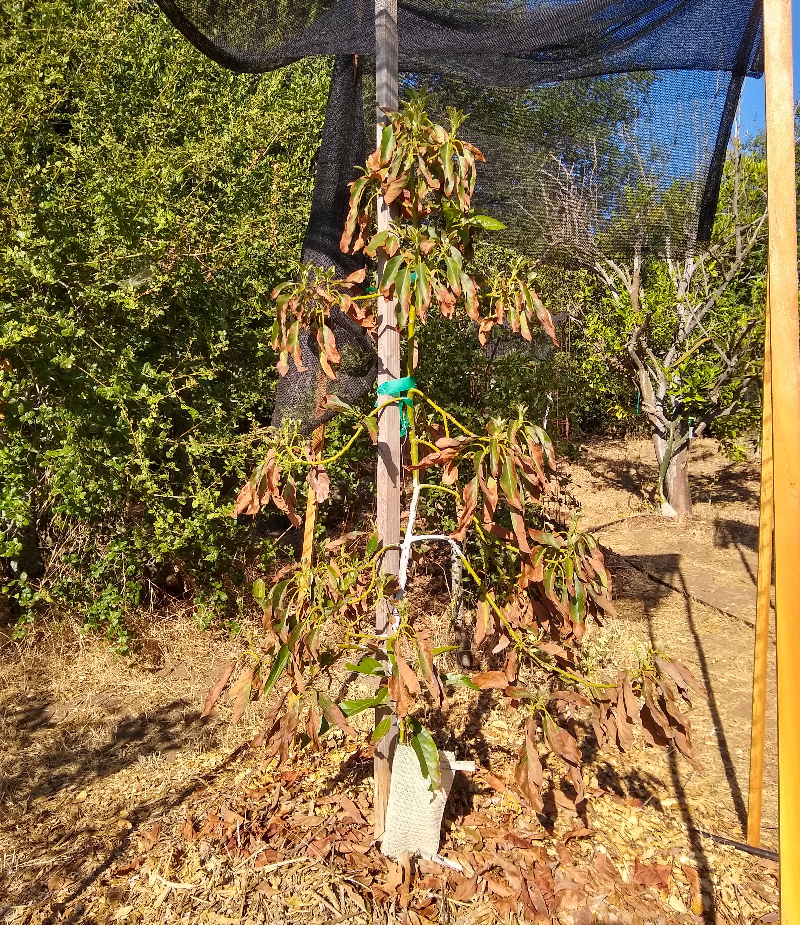
The GEM’s deteriorating health continued until the whole tree was crispy and dead by the end of summer.
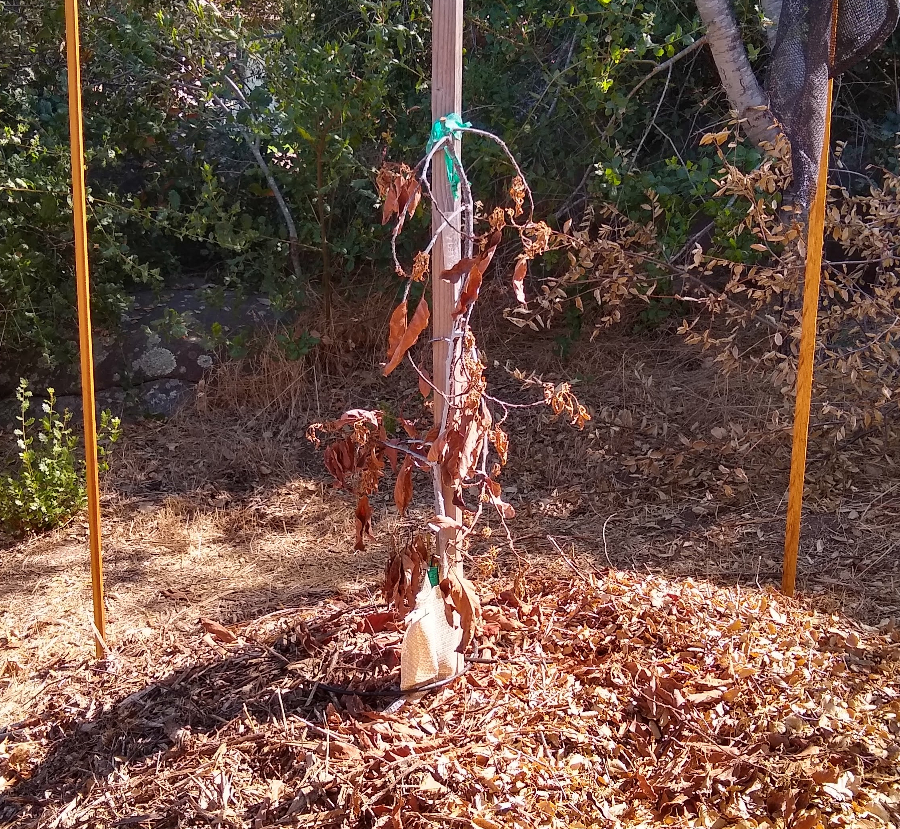
Why?
What killed my GEM?
Was it the heat of summer? Probably not. I’ve got dozens of other avocado trees in my yard that did fine through the same heat. Moreover, in the GEM tree’s first summer it coped with heat that lasted longer and reached higher temperatures.
Was it a bad rootstock? Doubt it. The tree was on a clonal rootstock called Leola. And though I don’t have more trees on that rootstock to compare to, I had planted two other trees on two different rootstocks on the same day in the same area in June of 2023, and their lives had a similar trajectory. They grew well the first year, and then declined in the second.
For example, I planted this Maluma avocado tree that was on a clonal Dusa rootstock right by the GEM:
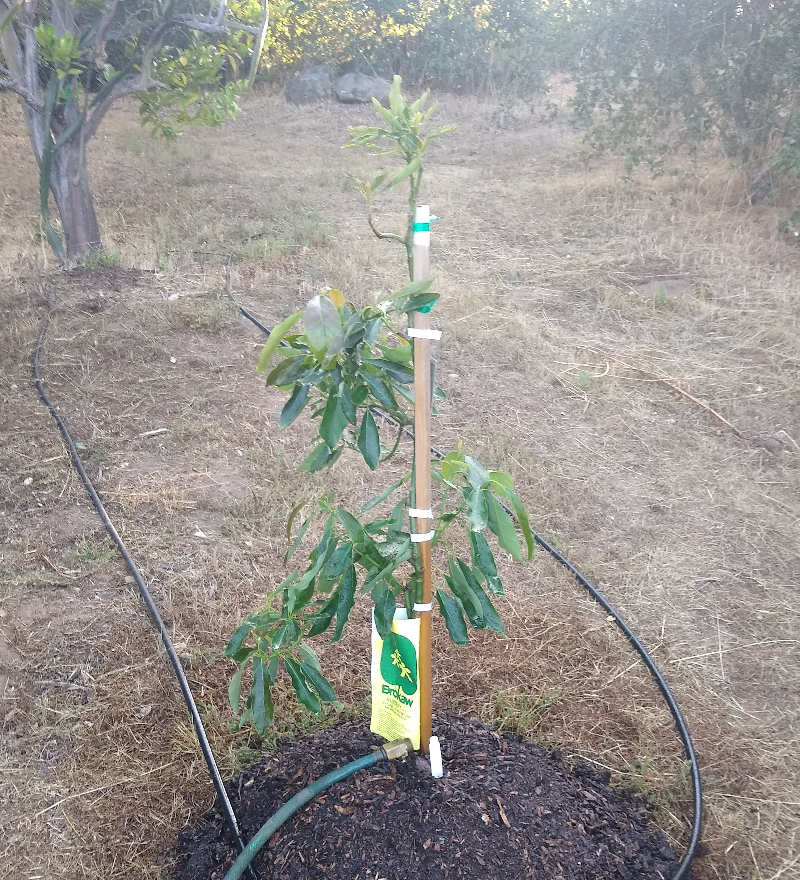
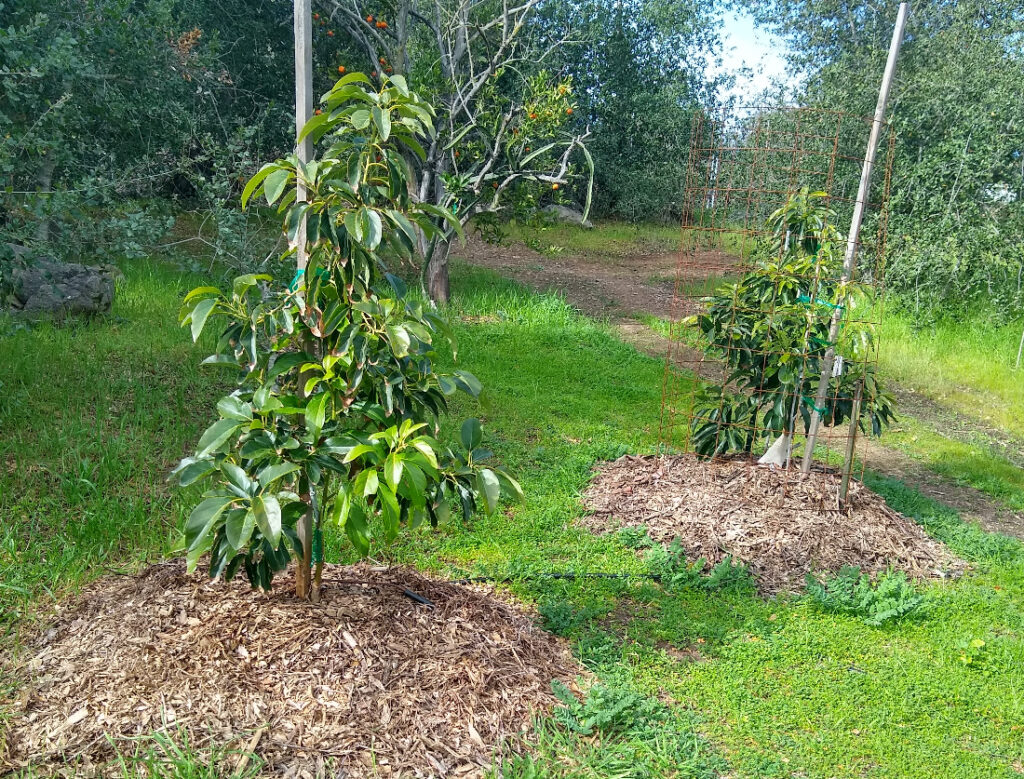
The Maluma on a different rootstock also declined in its second summer until it was dead soon after the GEM died.
Incidentally, I’ve got older avocado trees on Dusa rootstocks elsewhere in my yard that are growing well.
Was it a disease in the dirt? I don’t think so.
I think the main cause of the decline of these trees has to do with water and root competition.
How to identify avocado roots
Avocado roots are white or cream-colored if healthy, they do not have fine branchlets (“hairs”), they are about as thick as a spaghetti noodle, they are brittle and easily snapped (not fibrous, flexible, woody), and when snapped they smell like anise (black licorice).
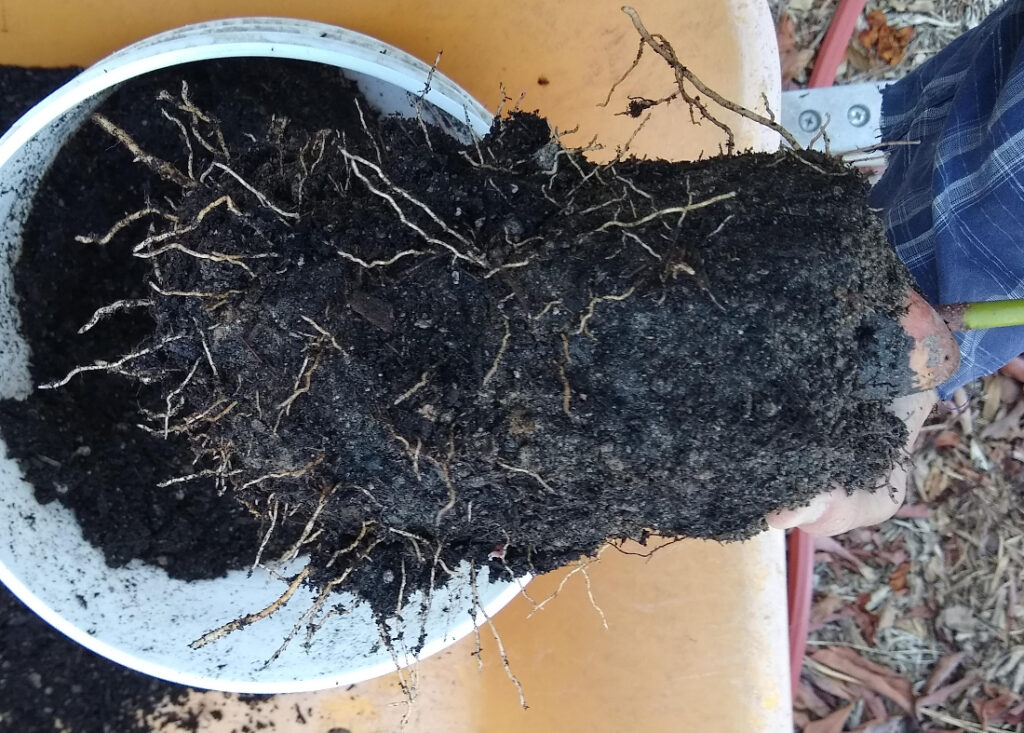
However, when I did an autopsy of the GEM and Maluma trees, I found some avocado roots but far more non-avocado roots.
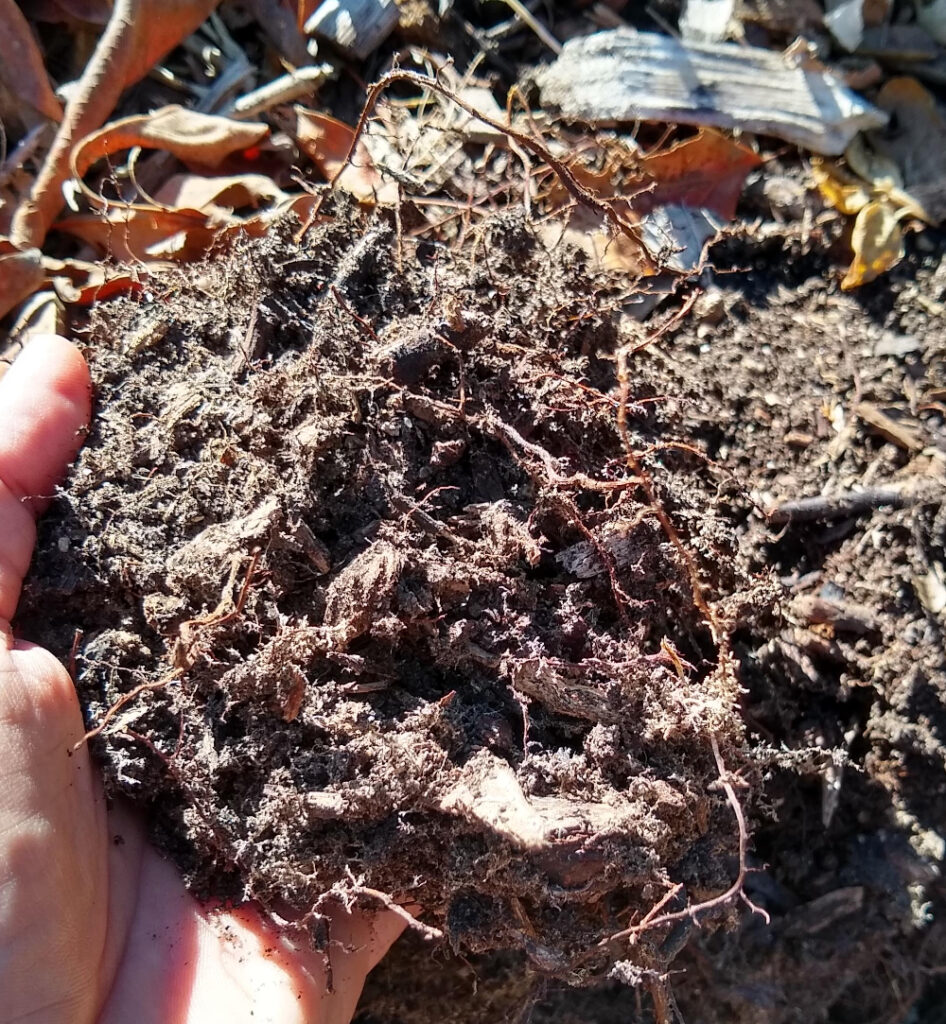
It was mostly oak roots under those trees. I had planted them near a number of oak trees, and the oaks had found the irrigation I was giving the avocados and they proliferated roots there, ultimately stealing so much water and soil space that the the young avocados collapsed.
Young avocado trees cannot handle competition
I’m embarrassed that I hadn’t seen this coming because I’d seen young avocados struggle near competition elsewhere in my yard and in many other yards for years.
Here is the pattern: You plant the tree and it grows well for a few months, or even a year or two, but then growth slows, and the leaves don’t get full size or deep green, and the leaves have brown edges, and then the tree just stops gaining in size. If it is in an inland, hot location like mine, it usually dies off, but in a cooler, coastal location, it usually remains alive and stunted for many years.
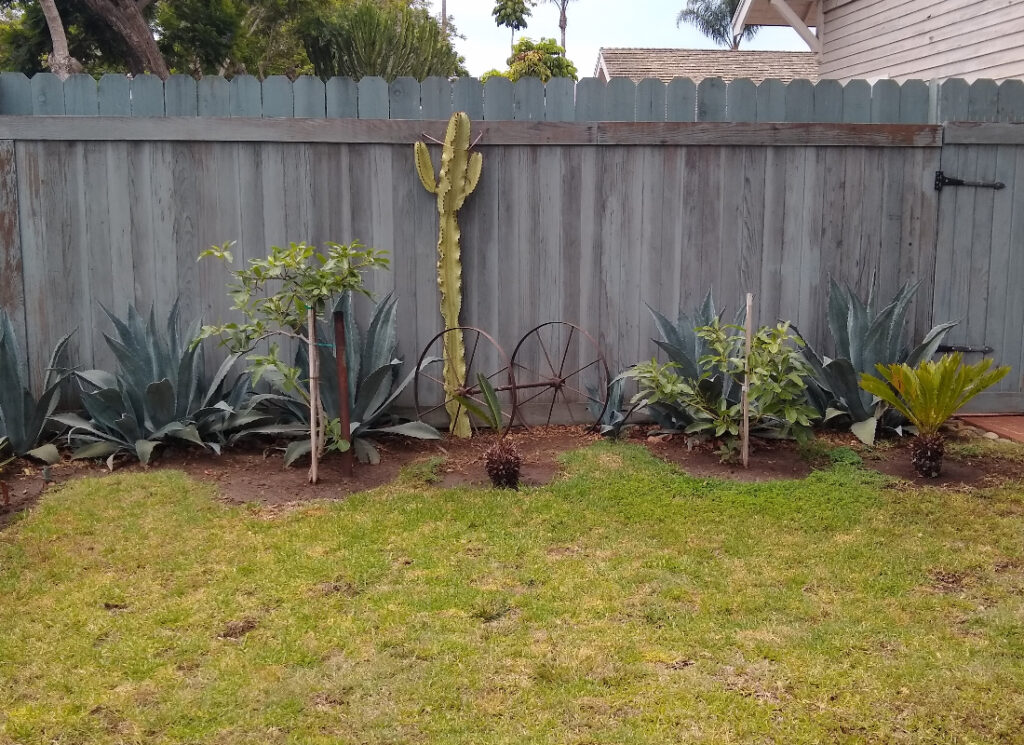
You think fertilizer might help, you think it’s not enough water, you think it’s a disease, you think the nursery sold you a bad tree, but no. If you scratch and dig under the tree and find a bunch of non-avocado roots, then that is the main problem.
When I see this competition problem, I see it caused by a specific group of bushes and trees over and over. They are usually native or naturalized types. In other words, they’re known tough guys in our Southern California land.
Examples of plants that I’ve seen strangling young avocados include eucalyptus, live oak, scrub oak, sumac, buckwheat, camphor, various cactuses, pepper trees, grapevines, and lawns (especially St. Augustine or Bermuda).
(See my post on removing Bermuda grass.)
What can you do?
I know of six ways to manage this situation. From most effective to least effective:
1. Remove the competition. If you do this, then problem solved.
Some friends on the Central Coast of California grow many avocados but a few of their trees in one area were perennially stunted. They eventually dug near the trees and discovered roots the size of irrigation pipes leading back to their mulberry tree, about fifteen feet away. They removed the mulberry, and now the avocados are rocketing up with new growth.
2. Reduce (prune) the competition. If you do this, then problem mitigated. I have done this many times elsewhere in my yard, especially with oaks and sumacs, and if you prune enough and prune soon enough, then the young avocado will still grow although never as well as if the competition were totally removed.
3. Cut competing roots. You can do this with a shovel at planting time, or you can do it anytime after planting. I aim to do it at least once a year for some of my trees, slicing with a shovel just outside of the irrigated zone of the avocado trees. The deeper you cut, the better, but cutting down only a foot is better than nothing. Also, it is more effective if you make a trench (even temporarily) rather than just slice.
Once at a farm in Ventura, I noticed that the avocado trees next to a large live oak tree were smaller than all the others. The farmer told me that at planting time he had dug a trench to cut all the oak roots near the new avocados. That helped the young trees get established without immediate competition; however, since then he had not trenched to cut the oak roots again.
When I visited the farm a year later, the trees (GEM variety) nearest the oak had become even further stunted and one was completely dead. The pattern was plain to see: the farther the trees were from the oak, the bigger, greener, and more fruitful they were.
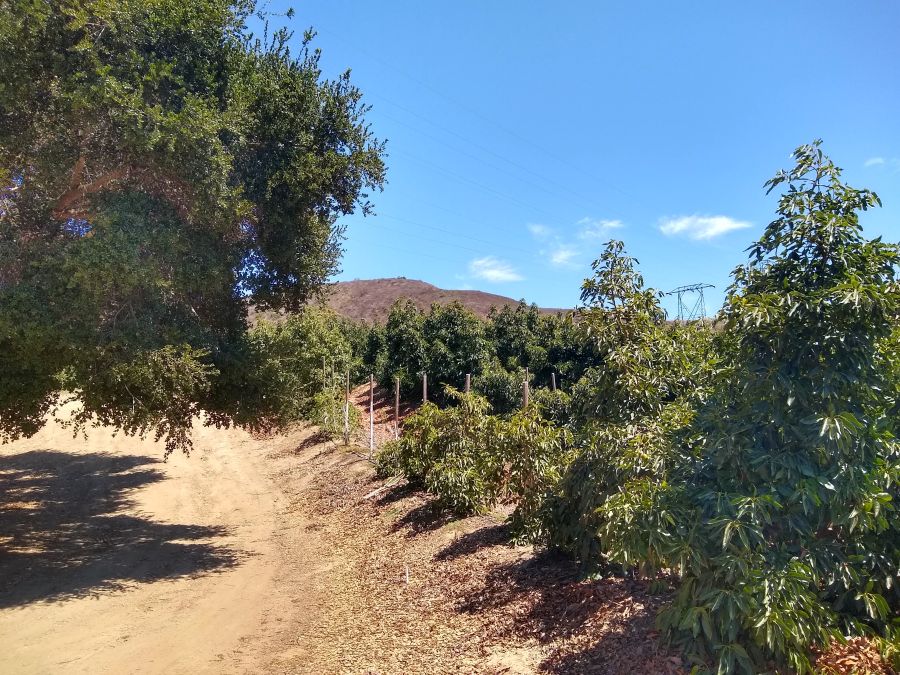
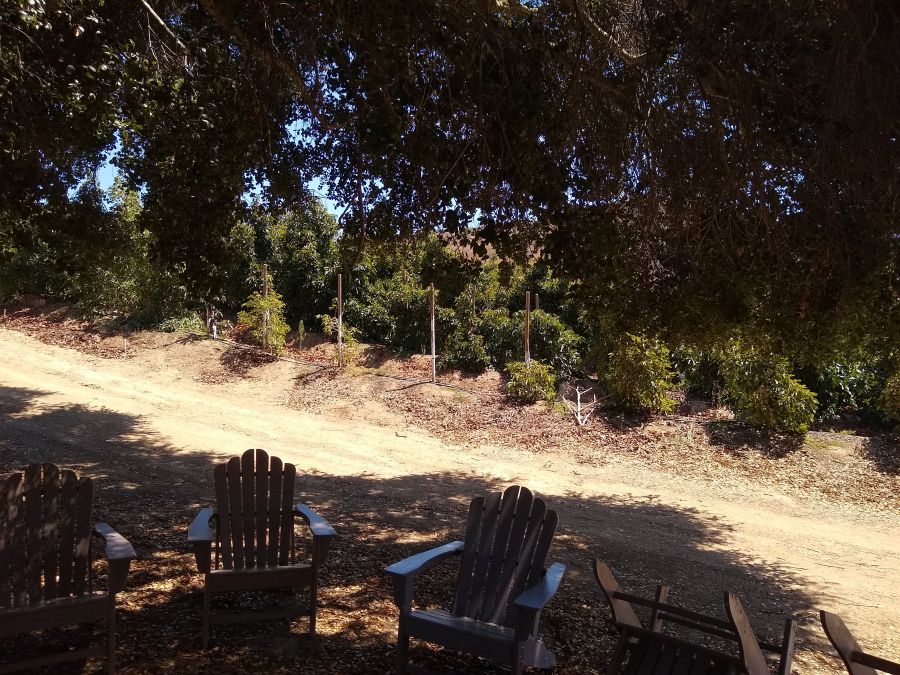
4. Dig a wide planting hole. This gives a new avocado tree more space and time to establish its own root system before dealing with competition.
5. Plant a bigger tree. Rather than a 3-gallon sleeve, you can plant a 15-gallon tree, for example. Such a bigger tree has a bigger root system and can better manage the impending competition. I’ve seen this help in my yard and in others’.
6. Water more and more broadly. Rather than putting a single drip emitter next to the trunk of the tree and giving it as much water as it would need without competition, apply water to a larger area and apply more water than the tree alone needs.
Read about how this worked for some young avocado trees growing near a pepper tree that suffered from the pepper’s root competition during a study of drip irrigation on avocado trees in California. “The [avocado] trees defoliated and looked bad until three more emitters per tree were added by a branched line. Subsequently, the three affected trees returned to excellent condition,” reported Don Gustafson in the 1979 Yearbook of the California Avocado Society.
Bonus: Use seedling rootstocks. I have noticed that, generally speaking, seedling rootstocks are tougher than clonal rootstocks as very young trees (not necessarily as mature trees). So if you are planting in a location with competition, and for some reason you can’t reduce the competition, then using a vigorous seedling rootstock such as Zutano or G6 is likely to help.
(My post, “Avocado rootstocks: what do they matter?”)
Every tree is in a different situation. You might have a neighbor with a giant eucalyptus that you can’t remove, but you can employ all of the other strategies.
For me, I’ve already begun replanting the area of my yard where the GEM and Maluma trees died, but I’m also pruning or removing some of the closest oaks, in addition to using some of the other strategies.
And note that older avocado trees cannot win a root competition with tough plants either. It’s just that they are less likely to die from it, and they are more likely to recover if the competition is mitigated. See my Hass tree here:
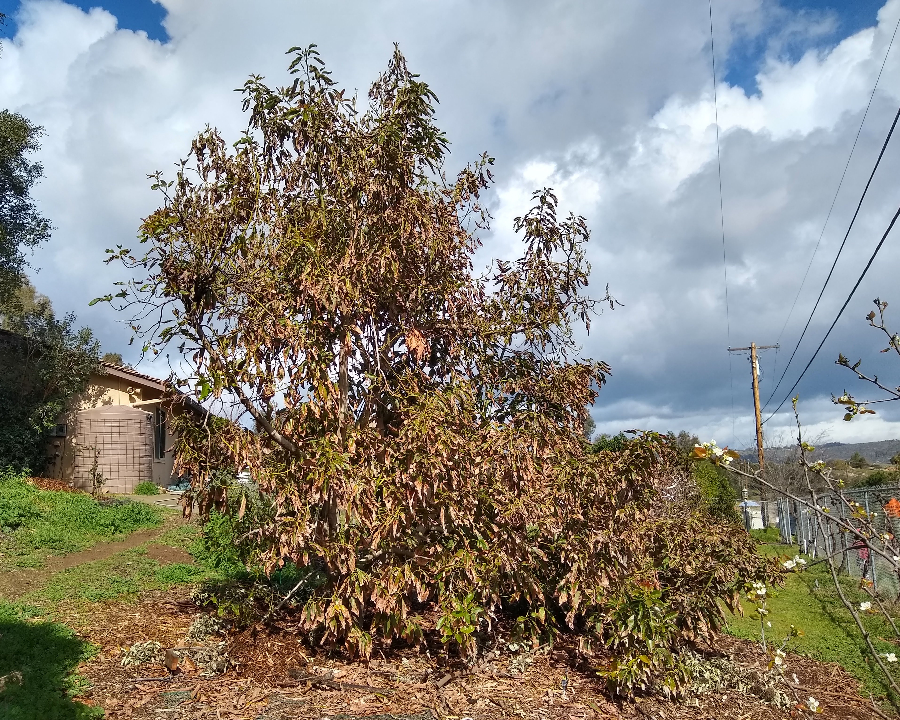
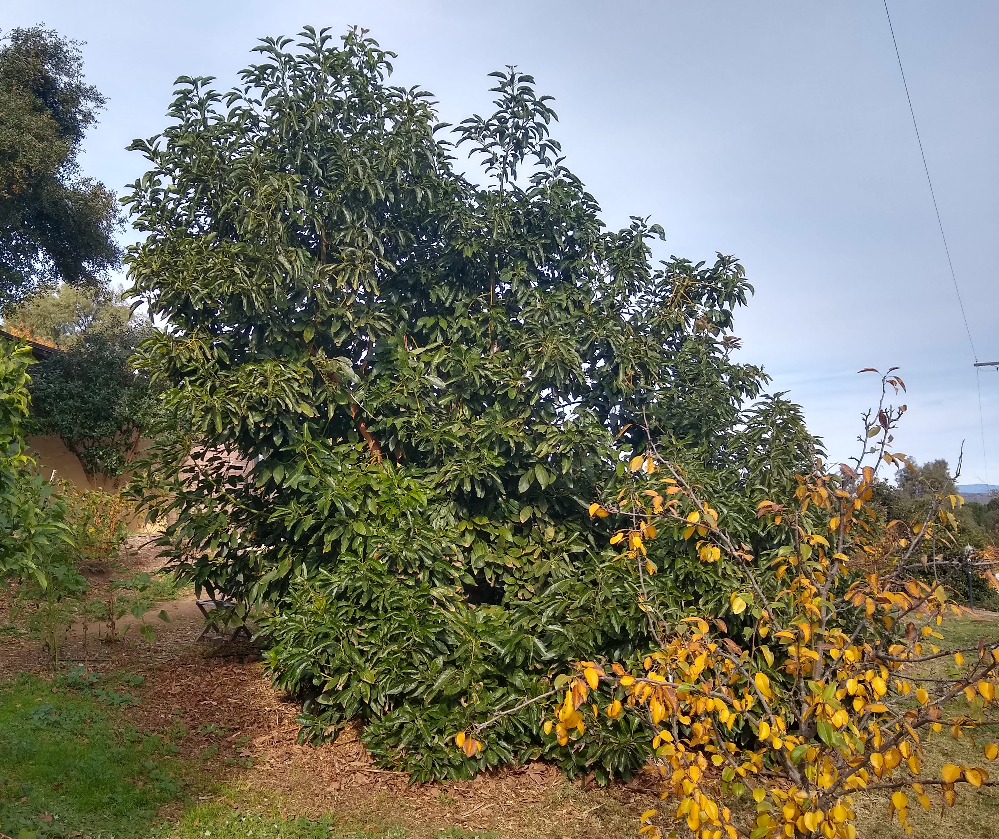
Thanks for your support of my Yard Posts. It allows me to keep them coming and keep them ad-free.
All Yard Posts are listed HERE

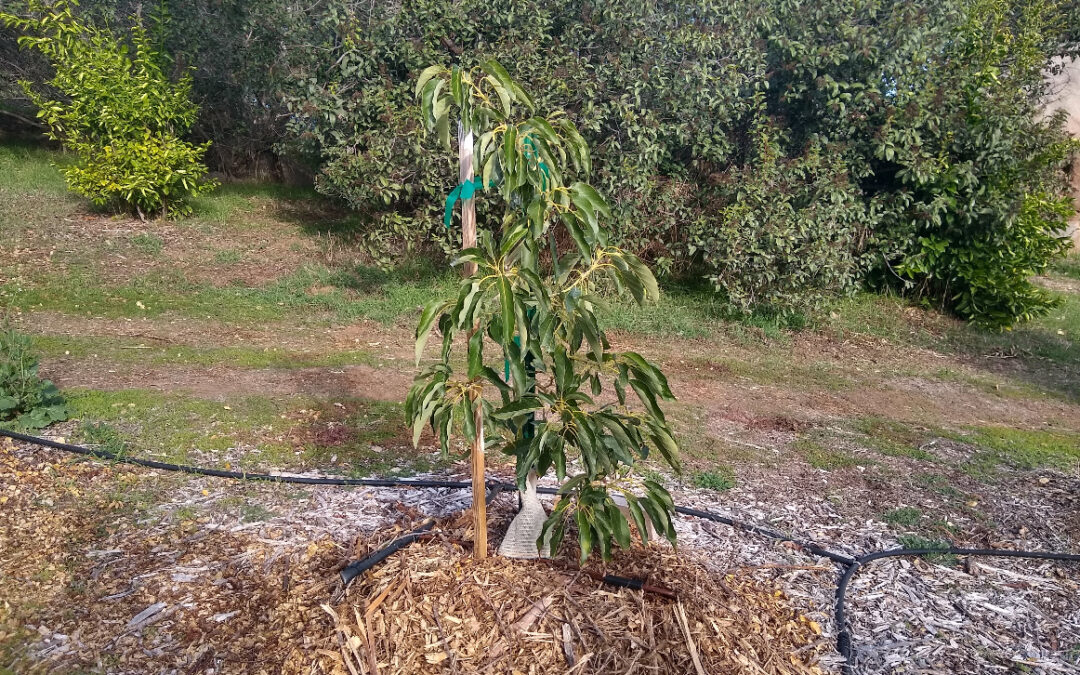


When I first started planting my Avocado trees I had one spot in the yard 10 feet from an oak tree that killed 3 consecutive avocado trees before I learned my lesson and planted something different. I went with an italian variety (with its respective recommended pollinator) and it competes well with the oak tree. I also prune the oak tree back every couple years. The olive tree is flourishing. Still sad I lost those Avocado Trees 🙁
I didn’t know all of this, I wish I can show you my before and now avocado tree I planted from a seed. I was doing good for 3 years and 1 died the other is slowly dying. I was happy to see I had alot of flowers and avocado. Then the avocado stared to dry.
I’ve been trying to figure out what’s killing the 3 foot tall GEM avocado we planted early this spring. Being in the high desert, I assumed it was too much sun. But shade cloth hasn’t helped, nor has extra water. After reading this, I’m convinced it’s the creosote bushes that grow abundantly around our yard.
Timely post Greg, I’ve been watching in slow motion a variegated schefflera put two gems in very poor condition, leaves browning, undersize fruit.
So you have an avocado tree that doesn’t seek a water source vs an invasive plant that will steal the water from your kitchen sink. The schefflera goes back into a pot today.
I can only hope the gems recover as well as your hass did.
Thanks Dennis
How far is far enough? “Drip line”? Or some distance beyond dripline?
PS 2025,01,18 eating last of Holiday avos, first of Bacon that survived raccoon and skunk scallywags. Pepper spray trees weekly, pretty effective, not cheap. Thrip damaage light this dry year.
Hi John,
Wish I could give a number for how far is far enough, but it depends on so many things. A couple of generalities are that the bigger (or more numerous) the tough plant is, the farther away the young avocado should be planted. So a single tiny avocado tree planted right at the canopy edge of a 50-foot live oak is a recipe for disaster; however, a tiny avocado tree planted just ten feet away from a tiny live oak sapling is manageable (until/unless the sapling grows big).
Another is that if you have many other irrigated plants near the tough plant, then the root competition on the young avocado will be less because the tough plant can also get plenty of water at those other locations; therefore the distance between the avocado and the tough plant can be closer.
In my own observations, I’ve found roots from a large live oak tree in my yard about 60 feet from its trunk. And I’ve found roots from an established grapevine twenty feet from its trunk.
Still eating Holidays? Wow. I’ve never known Holidays to hold so long, but you are in a mild, coastal location, right?
Thanks. I think I will give up my idea of planting a live oak and keep the avocados.
Yes, Holidays seem to flourish very close to the coast. Less than 2 miles from the water in one direction, and half a mile from San Pedro Bay. Trees do surprisingly well in this area if given the chance. It must be either underground springs, or some interaction between sea water and fresh ground water. Port of LA has planted sycamores 50 yards from the channel and they are doing fine. I have not watered my citrus for years and they produce amazingly. Guess I lucked out.
I need advice for a 5-years-in-the-ground Hass avocado whose branches were stripped of leaves during last week’s windstorm. Is there any benefit to pruning back some of the stripped branches? Perhaps to help it direct energy towards fewer places? Or do I let it alone, trusting that the tree will again sprout enough leaves for it’s summer coverage and have the energy to blossom when the time comes? This was the first year it set on lots of fruit, 80% of which was also blown off the tree by the winds. Recovery advice?
Sorry to hear it, Dena. I would do nothing for now. The tree should start growing new leaves within a month or two. If it’s March and the leaves haven’t filled in, then paint the branches white to protect from sunburn (you can do this even now if you want).
To all,
California is an arid Mediterranean climate with low rainfall.
For best growth and yields avocado trees need a minimum amount of water each year, approximately 40-50 inches of rain, and moist soils in order to support the number of roots needed for healthy avocado trees.
The avocado tree does not search for water therefore water needs to be provided to the trees at the right times. In addition, the majority of avocado roots are in the top six inches of soil under the canopy out to the drip line — this soil is prone to drying out.
CALIFORNIA AVOCADO COMMISSION
Do you know if ice plant is a problem competitor?
Thanks for this post. I should pull out some salvia and nasturtiums that self seed in the mulch under my avo trees.
Thinking about it, many of the old avo trees I’ve seen in yards don’t have ground cover/”green mulch”. One exception is the avocado grove at Easlen in Big Sur, CA–as I recall it’s covered in dense Salvia spathacea https://www.canativeseeds.com/product/salvia-spathacea-hummingbird-sage-/547
I learn so much from your blog–thank you!
Hi AM,
If your trees are large (say, over 10 feet tall), then I wouldn’t worry about some salvia and nasturtiums under and around the tree. They can get along, as long as enough water is available. I know some farmers who plant nasturtium near their avocados as a cover crop and the results are good, as long as enough water is provided (which usually can be counted on in winter as rainfall). I grow oregano, melons, potatoes, phacelia, and some other plants right at the canopy edges of some of my large avocado trees and they get along fine.
It’s young avocado trees that are most vulnerable to competition, and a salvia would not be an ideal companion plant next to a young avocado because salvias are tough and perennial (whereas the nasturtiums die off when it heats up in late spring, which is when the avocado starts to need more water). I once saw young avocado trees suffer next to a few (native) buckwheat bushes until the buckwheat was pruned back severely and kept that way.
I learned that from my old house that palm trees roots from my neighbors house are aggressively water seeking ( by me digging 4 feet down seeking to destroy blackberries roots, yes rhey do grow that deep). When I moved to my current place ( chased away by ressirecting wild thorny blackberry ), we became owner the most magnificently beautiful gum tree in the neighborhood over 70 years with extensive roots reaching to the back of my house ( we dug a trench for a retaining wall for the future home of my avocado trees and found little gum tree sprouts coming from the extensive but shallow roots). The gum tree was beautiful, but I knew I wanted avocado trees so out it went. The avocado trees are shooting for the stars, except for my most vigorous grower the nabal that I chanced in a different location in the far back 10 feet from a eucalyptus tree. At first it did supper well, but had since stopped and went into decline after a year. It’s still a live however so I’m crossing my fingers. I can’t cut the eucalyptus since it’s behind my wall on city land and is protected by the city per the city policy. Hoping my nabal just draggs it feet along and survives this, but this spring I will be grafting it to my other trees just for insurance.
Funny thing, I’ve got an ice cream bean tree unintentionally planted near a live oak with the goal of stunting it as the ice cream bean is known for being aggressive and taking over. I’ve managed to keep that tree in check for years. On the other hand, I’ve had a few avocados near that tree and none of them have ever done well. Recently I pulled out a dying lamb hass that had been in the ground for at least six years and knocked all the dirt off of it and stuck it in an old bath tub on a deck. Somehow that thing lived and has been growing well since.
I always assumed avocados do not compete with each other given the way most orchards are planted. what about different varieties of avocado or citrus? I have two oranges and a mandarin 10-12 feet from newly planted avocados, has anyone ever had problems with citrus or other fruit trees stealing water?
Hi Chris,
Avocado trees can be planted next to each other and get along provided that they are planted at the same time. However, a young avocado planted next to a mature one will struggle. A mature avocado tree is far tougher than a young one and it will grow roots into that young one’s zone and drink its water. This is one reason that farmers have a hard time interplanting new trees among old ones. That said, a mature avocado tree is not as tough as the “tough” plants I mentioned above in the post.
And citrus trees are tougher than avocados. They can be planted together at the same time and do fine, but a newly planted avocado next to a mature citrus will struggle a little. I’ve seen this in my yard a couple times. I also shot this video of some avocados planted among mature citrus up in Redlands: https://gregalder.com/yardposts/the-importance-of-sun-and-water-for-avocado-trees/
The distance of your newly planted avocados from the citrus sounds like enough. But don’t skimp on the water and keep an eye out for signs of thirsty leaves, especially right now. I’ve noticed my citrus being especially thirsty this fall and winter. (And if they have access, your citrus will drink from the water you give to your avocado too.)
Nice to know I’m not the only one with struggling avocado trees!
Your experience seems to be identical to what happened to our avocado tree this last year. We kept scratching our head as to what was happening to it. We do have a couple of plants nearby like a few rose bushes, lavender plants, and ivy growing on the wall about 5′ away. And it butts up against our lawn less than a foot away. Our tree survived about a year and 3 months and it was a 15 gallong tree. 🙁
This is timely and appreciated post Greg as we are looking to plant 2-3 avocado trees in our orchard.
Regarding your brassica question, I had some aphids on my broccoli a while back, rinsed them off, and never saw another one. I thought it was odd because I always have such a problem with them. I did not use any netting. I have no idea what is going on!
Hi Greg,
I love you videos and your posts for knowledge on growing avocado and I think this post just answer another desperate question that I been having in mind of my first avocado tree (a Hass). I purposely planted my trees close to each other so I can plant some more trees in the limited space. However I couldn’t figure out why my Hass is having small leaves and not growing when I tried everything else until now! I need to start pruning the root of the other trees. I think the suspect in mind is the fig that I have 4 feet from it…
Priceless information. Thank you.
Hi Greg, Thank You. I am about to help a friend plant 2 avocado trees in early march. A 5 Gal. Fuerte and a 5 Gal. Lamb-Hass. His house is in his almond orchard in Hughson, CA. My first question is about the competition with the almond trees. How close is to close? FYI, The soil is very sandy loam. secondly, he was thinking of planting both in the same hole. Any thoughts about that?
Hi Dennis,
Fuerte and Lamb aren’t perfect partners for being planted in the same hole because Fuerte grows in a spreading manner whereas Lamb grows more vertically. But it can be done as long as you prune and train the trees sufficiently. I’d prefer to have them spaced apart a bit though, if that’s possible.
Almonds are certainly tougher than avocados, so the farther the better. But as long as the avocados are planted 20 feet or more from the closest almond, I’d say the competition will be minimal and manageable. If closer, I would dig a trench and cut almond roots near the avocados at planting time, for sure.
Last weekend I planted 2, 15 gallon avocado trees (Hass and Bacon) on a hillside. No recent issues with gophers in that section of the yard but have been a problem in other areas. Last minute I decided to line bottom and sides of the holes with 1/4” hardware cloth I had from another project (not a significant distance from the root ball). Now I’m worried I may be setting the avocado trees up for failure and cause them to be “root bound”. Different opinions depending on sites and if avocado trees will send roots through the small openings. What is your opinion? Does 1/4” hardware cloth leave too small an opening for new roots? Should I uproot and remove the hardware cloth or will that just cause a bigger problem?
New to growing avocados and had a Fuerte and Hass professionally planted 6 years with nothing to show for it. Had an expert come out and told me to give up on the Hass. When I dug it out found the installers had buried half the trunk (a good 6”) underground before any roots started. Was devastating and don’t know how it survived as long as it did…. Was certainly dying slowly the last 6 years.
There’s a Purple Leaf plum tree in a neighbor’s property and another in a vacant lot adjacent to ours, whose roots have killed two of my avocados. I didn’t realize their roots were the problem until I read your post. I dug trenches and found a few roots of 2 to 3 in diameter feeding off the water and nutrients of my avos. I cut the roots in two places creating a 2 to 3 inch gap so they wouldn’t grow back as quickly. The tree on the vacant lot is to be taken down (YAY!) as they plan to put a 4 plex on it. The other is directly behind our fence. The tree is 30 to 40 feet tall, has 10 to 15 foot branches over our property too high to reach even with a tall step ladder and an extendable chain saw.. Drops thousands of these small, round, purple plums which root easily and if not taken out within a year or two become near impossible to take out. The only solution in such a situation is to dig trenches every other year, find and cut the roots.
Hi Greg, you’ve covered competitive roots thoroughly.
Here’s another factor that I haven’t seen mentioned. Avocado leaf stomata shut down (close) around 100°F. This means respiration stops, the roots no longer take in water, and the leaves no longer cool themselves through transpiration. So you can expect to see leaf wilt when temperatures above 100F extend for several hours in a day, or persist for more than a couple days. As Central America natives, the trees did not evolve to handle extreme heat (and low humidity). The shallow roots like it neither too dry, or TOO WET.
The danger for a grower, is to see leaf wilt during hot weather and increase irrigation. The problem with that is if the trees are responding to heat by closing their stomata, the trees are taking up water actively, and you could actually waterlog the soil, increasing probability of root rot. I learned this lesson the hard way, and now have phytopthera root rot in my grove.
So rather than respond solely to hot temperatures or leaf wilt, look under the mulch and see if the root zone is dry. If not, don’t add more water. And yes, mulch is critical.
In my SJV location, on “normal” hot summer days, my trees recover overnight when it cools down. When max temperatures exceed 106+ (imprecise observation), for 3 days or longer, the trees never fully recover, they lose some leaves and fruit will abort. Phytopthera root, once present, root can kill the tree slowly.
My experience is Gems and Lambs tolerate summer heat much better than Hass.
Hi Jed,
I love the way you put this: “rather than respond solely to hot temperatures or leaf wilt, look under the mulch and see if the root zone is dry. If not, don’t add more water.”
That is such good advice. I guess it’s hard to follow because when we see a tree wilting we want to help it. But “don’t water wet dirt” is a rule we must keep in mind.
It’s probably also hard to follow because we can be lazy about getting down on our knees and scratching and digging to see how much moisture is in the dirt. Being able to judge a tree’s water needs from just looking at the leaves would be so much more convenient!
I remember seeing your GEMs and Lambs compared to your Hass a few years ago. In terms of heat tolerance, my main impression from the brief visit was that the GEMs had slightly fewer sunburned fruit because they held the fruit inside their canopies a bit more. Here’s the post I wrote that included the visit: https://gregalder.com/yardposts/growing-avocados-in-californias-central-valley/
Hope your summer has been relatively mild like ours this year.
I found the information on the (root competitions), to be intereseting.
About a year ago, I planted a new Pinkerton avo close to my mature Hass.
They are only about 14 feet from each other. The pinkerton seems to be okay at this time, but after having so many good crops of hass, this last year, most of the blooms dropped off and there may only be 2 dozen or less fruit hanging on.
I may have to move the pinkerton, but there is also a ground cover all around the base of the hass tree. Even with proper fertilization, I think the vines that are covering the bass of the avocado, may be more of a problem, then I thought in the beginning.
Spraying the ground cover, has hardly helped. It seems to thrive, even though i cut the vines back every fall. Thanks for all the info. I’ll have to get busy when this heat passes us.
We are on the third week of 95o plus temperatures here in Fallbrook.
Lord, please send rain, soon.
Looking at the space I would assume you had enough room for your tree. I would have to say you might not have water enough to the canopy as well as not enough deep watering. These young trees really do need some shade. I have one Gem that is so close to my Pepper tree and it’s half of the time shaded. I always wondered how it would do. It had its first fruit this year. I still don’t know how it will perform but it gets deep watering. I drop the hose along with the bubbler. I think some trees need more and the first indication I see is the tips will brown if they are not getting enough water. My Zutano seems to be more water hungry than my other trees. Next I would say my Fuerte needs more as well. Taking care of these trees is tremendous and much depends upon our weather and water. High temps. really take their toll. Everything we do is figuring out the needs of each tree.
Hi Greg; Great post on those precocious GEM’s. Took you a lot of work to finely arrive at your cause of death, by Oak. Overall it does give me some solace in that I’m not the only one who has lost a GEM or two. I don’t use a moisture meter rather a T handle “hollow” tube I put down 12-14” to find the moisture of the soil there. Found out I was in fact “not’ providing enough water with 1 x 4GPH emitter and had to add 2 x 1GPH. 2 hours “on” = 12 gallons/week. Needed during Aug/Sept (15g GEM) in Oceanside.
Any info on the “Little Cado” avocado tree. The tag states it will reach 15ft. And I bought it 3yrs ago, with a large avocado, & when ripe became black & huge, and very creamy delicious & better than my Hass. I never see anything mentioned related to this “Little Cado”. And its also been a fast grower.
Hi Greg: I blew it. Long story short, when I planted two Hass trees in November of 2021, I was concerned about drainage and used the raised method discussed in one of your posts. I was hopeful that while the root ball was above ground, the roots would eventually find their way downwards over time.
4 years later, it seems like the growth of both trees is heavily stunted. I’ve noticed the soil that is raised above the ground erodes over time. I replenish the soil every 6-months or so, but I fear the trees are essentially growing in a pot and therefore are not reaching their full potential. I’m super disappointed because they were planted in a prime location. If I could do it over, I would have just put them in the ground. Does the above ground method stunt long-term growth potential? I don’t see a scenario where these trees will develop into large, beautiful specimens understanding the root ball is above ground in constantly eroding soil. Thank you for any suggestions.
Hi Cameron,
I find it best to encircle mounds with poultry wire to prevent erosion. Then you can load in wood chips or other mulch up to the top of the poultry wire and the avocado roots will grow throughout that mulch.
There are some pictures for reference here: https://gregalder.com/yardposts/planting-avocados-in-poor-soil/
Also, you might increase watering. Trees on mounds do need a bit more water than trees at grade, in my experience. It’s also nearly impossible to overwater trees on mounds.
If your trees are sickly and heavily stunted, then maybe it’s best to just cut your losses and start new trees (and maybe plant at grade). But if the foliage is somewhat dense, then I would try the above ideas and see if the trees respond.